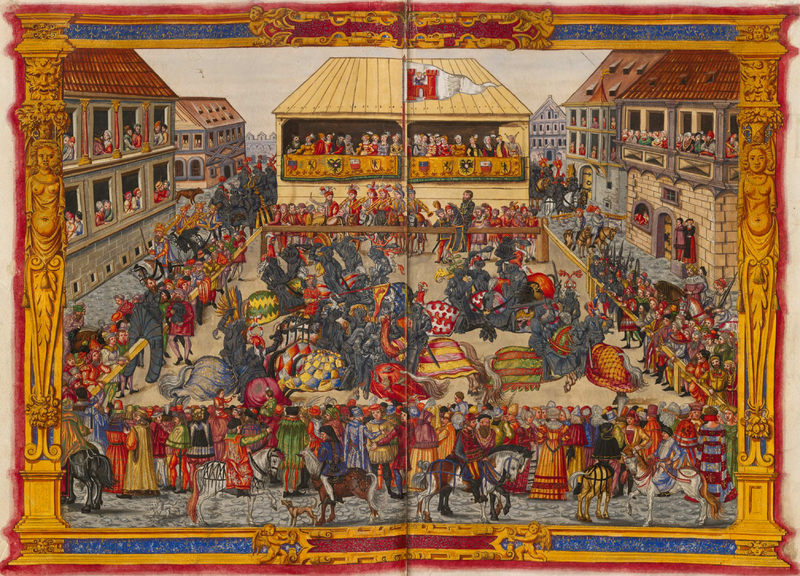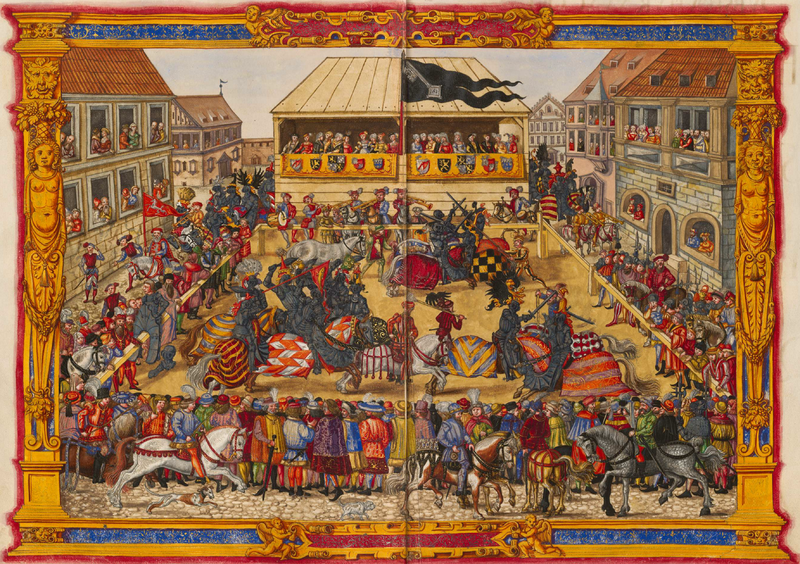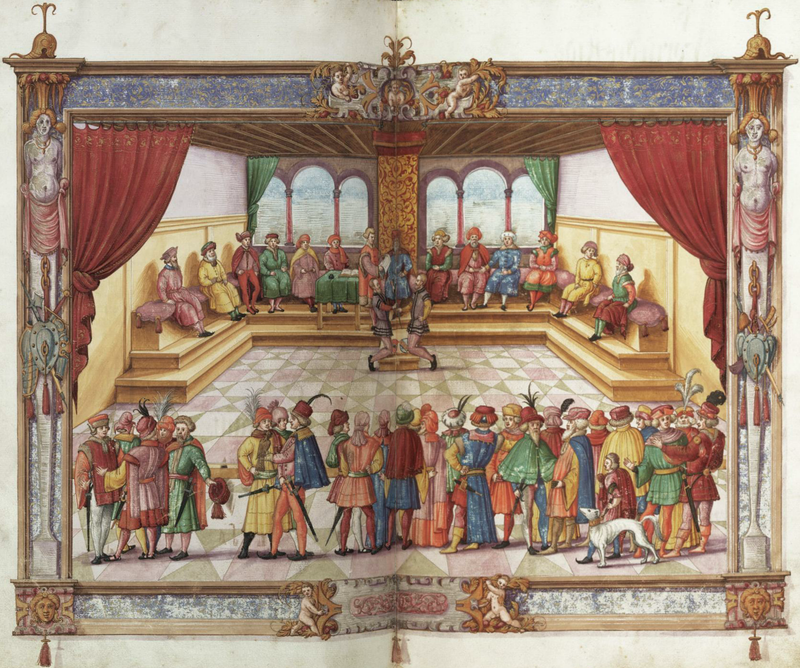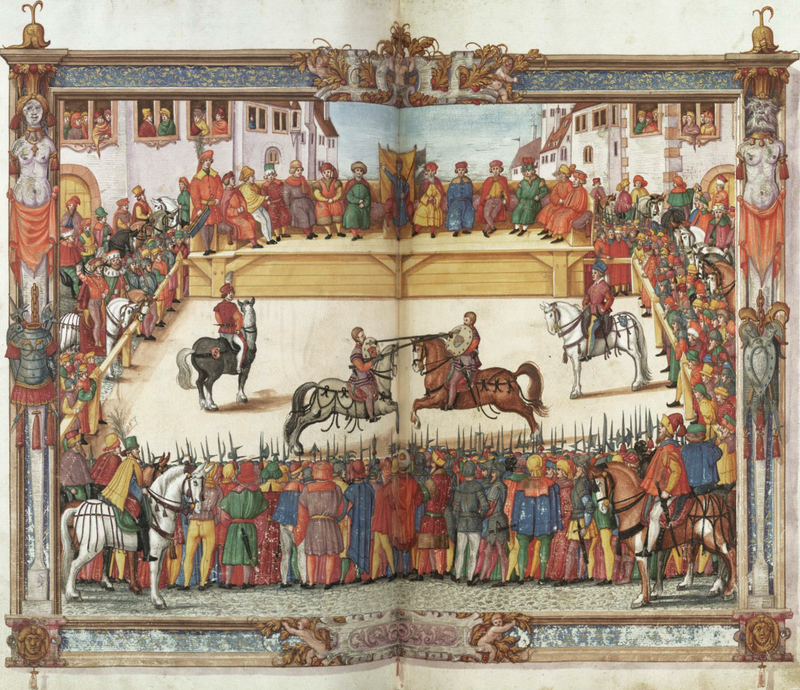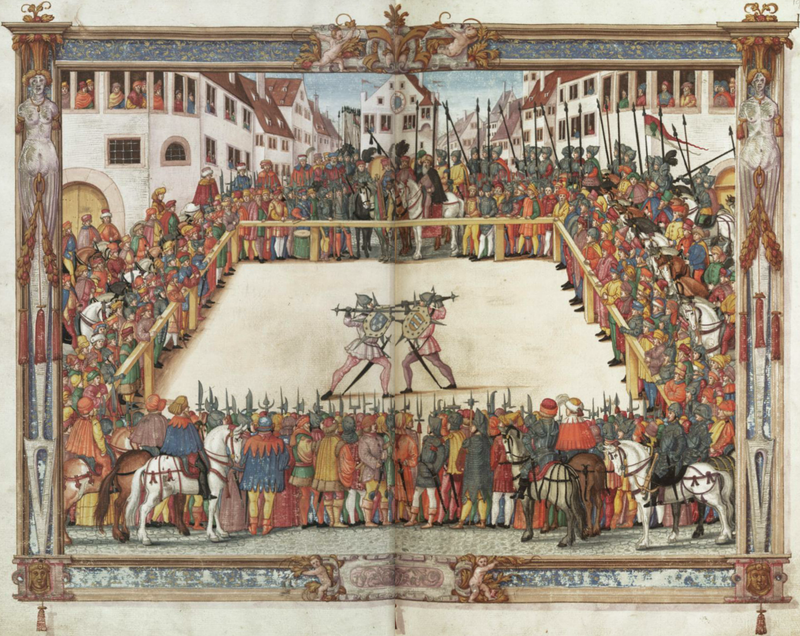|
|
You are not currently logged in. Are you accessing the unsecure (http) portal? Click here to switch to the secure portal. |
Difference between revisions of "Paulus Hector Mair/Tournament book"
| (5 intermediate revisions by the same user not shown) | |||
| Line 1: | Line 1: | ||
<noinclude><div style="width:240em;"></noinclude> | <noinclude><div style="width:240em;"></noinclude> | ||
| − | {| class=" | + | {| class="master" |
|- | |- | ||
! <p><includeonly><span style="font-weight:normal; font-size:85%;">[{{edit|Paulus Hector Mair/Tournament book|edit}}]</span> </includeonly>Source Images</p> | ! <p><includeonly><span style="font-weight:normal; font-size:85%;">[{{edit|Paulus Hector Mair/Tournament book|edit}}]</span> </includeonly>Source Images</p> | ||
! <p>Images<br/>from the [[Opus Amplissimum de Arte Athletica (MSS Dresd.C.93/C.94)|Dresden]] and [[Opus Amplissimum de Arte Athletica (Cod.icon. 393)|Munich]] Versions</p> | ! <p>Images<br/>from the [[Opus Amplissimum de Arte Athletica (MSS Dresd.C.93/C.94)|Dresden]] and [[Opus Amplissimum de Arte Athletica (Cod.icon. 393)|Munich]] Versions</p> | ||
| − | ! <p>{{rating | + | ! <p>{{rating}}</p> |
! <p>[[Opus Amplissimum de Arte Athletica (MSS Dresd.C.93/C.94)|Dresden II Transcription]] (1540s){{edit index|Opus Amplissimum de Arte Athletica (MS Dresd.C.94)}}</p> | ! <p>[[Opus Amplissimum de Arte Athletica (MSS Dresd.C.93/C.94)|Dresden II Transcription]] (1540s){{edit index|Opus Amplissimum de Arte Athletica (MS Dresd.C.94)}}</p> | ||
! <p>[[Opus Amplissimum de Arte Athletica (Cod.10825/10826)|Vienna II Transcription]] [German] (1550s){{edit index|Opus Amplissimum de Arte Athletica (Cod.10826)}}</p> | ! <p>[[Opus Amplissimum de Arte Athletica (Cod.10825/10826)|Vienna II Transcription]] [German] (1550s){{edit index|Opus Amplissimum de Arte Athletica (Cod.10826)}}</p> | ||
| + | ! <p>[[Opus Amplissimum de Arte Athletica (Cod.icon. 393)|Munich II Transcription]] (1540s){{edit index|Opus Amplissimum de Arte Athletica (Cod.icon. 393 II)}}</p> | ||
! <p>[[Opus Amplissimum de Arte Athletica (Cod.10825/10826)|Vienna II Transcription]] [Latin] (1550s){{edit index|Opus Amplissimum de Arte Athletica (Cod.10826)}}</p> | ! <p>[[Opus Amplissimum de Arte Athletica (Cod.10825/10826)|Vienna II Transcription]] [Latin] (1550s){{edit index|Opus Amplissimum de Arte Athletica (Cod.10826)}}</p> | ||
| − | |||
! <p>[[Jörg Breu Draftbook (Cod.I.6.2º.4)|Draftbook Transcription]] (1540s){{edit index|Jörg Breu Draftbook (Cod.I.6.2º.4)}}<br/>by [[Michael Chidester]]</p> | ! <p>[[Jörg Breu Draftbook (Cod.I.6.2º.4)|Draftbook Transcription]] (1540s){{edit index|Jörg Breu Draftbook (Cod.I.6.2º.4)}}<br/>by [[Michael Chidester]]</p> | ||
| Line 14: | Line 14: | ||
| | | | ||
| | | | ||
| − | | <p> | + | | <p>[01] </p> |
| | | | ||
| + | | {{section|Page:Cod.10826 157r.png|1|lbl=157r}} | ||
| | | | ||
| − | | | + | {{paget|Page:Cod.icon. 393 II|124r|jpg|p=1}} {{section|Page:Cod.icon. 393 II 124v.jpg|1|lbl=124v|p=1}} |
| − | | {{ | + | | {{section|Page:Cod.10826 173r.png|1|lbl=173r}} |
| | | | ||
| Line 24: | Line 25: | ||
| | | | ||
| | | | ||
| − | | <p> | + | | <p>[02] </p> |
| − | |||
| − | |||
| | | | ||
| | | | ||
| + | | {{section|Page:Cod.icon. 393 II 124v.jpg|2|lbl=-}} | ||
| | | | ||
| − | |||
| | | | ||
|- | |- | ||
| | | | ||
| − | | | + | | |
| − | | <p> | + | | <p>[03] </p> |
| − | |||
| − | |||
| | | | ||
| | | | ||
| + | | {{section|Page:Cod.icon. 393 II 124v.jpg|3|lbl=-}} | ||
| | | | ||
| − | |||
| − | |||
| − | |||
| | | | ||
|- | |- | ||
| − | |||
| − | |||
| | | | ||
| | | | ||
| + | | <p>[04] </p> | ||
| | | | ||
| − | |||
| | | | ||
| − | |||
| − | |||
| | | | ||
| − | | | + | {{section|Page:Cod.icon. 393 II 124v.jpg|4|lbl=-|p=1}}<br/>{{section|Page:Cod.icon. 393 II 125r.jpg|1|lbl=125r|p=1}} |
| − | | < | ||
| − | |||
| − | |||
| | | | ||
| | | | ||
| + | |||
| + | |- | ||
| | | | ||
| − | |||
| | | | ||
| − | + | | <p>[05] </p> | |
| − | |||
| − | |||
| − | | <p> | ||
| | | | ||
| | | | ||
| + | | {{section|Page:Cod.icon. 393 II 125r.jpg|2|lbl=-}} | ||
| | | | ||
| − | |||
| | | | ||
|- | |- | ||
| | | | ||
| − | | | + | | |
| − | | <p> | + | | <p>[06] </p> |
| − | |||
| − | |||
| | | | ||
| | | | ||
| + | | {{section|Page:Cod.icon. 393 II 125r.jpg|3|lbl=-}} | ||
| | | | ||
| − | |||
| | | | ||
|- | |- | ||
| − | |||
| − | |||
| | | | ||
| | | | ||
| + | | <p>[07] </p> | ||
| + | | | ||
| + | | {{section|Page:Cod.10826 157v.png|1|lbl=157v}} | ||
| + | | | ||
| + | {{section|Page:Cod.icon. 393 II 125r.jpg|4|lbl=-|p=1}} {{section|Page:Cod.icon. 393 II 125v.jpg|1|lbl=125v|p=1}} | ||
| | | | ||
| − | |||
| | | | ||
|- | |- | ||
| − | |||
| − | |||
| − | |||
| − | |||
| − | |||
| | | | ||
| | | | ||
| + | | <p>[08] </p> | ||
| | | | ||
| − | |||
| | | | ||
| − | |||
| − | |||
| − | |||
| − | |||
| | | | ||
| + | {{section|Page:Cod.icon. 393 II 125v.jpg|2|lbl=-|p=1}} {{section|Page:Cod.icon. 393 II 126r.jpg|1|lbl=126r|p=1}} | ||
| | | | ||
| − | |||
| − | |||
| | | | ||
|- | |- | ||
| | | | ||
| − | |||
| − | |||
| − | |||
| − | |||
| | | | ||
| + | | <p>[09] </p> | ||
| | | | ||
| | | | ||
| − | | {{section|Page:Cod.icon. 393 II | + | | {{section|Page:Cod.icon. 393 II 126r.jpg|2|lbl=-}} |
| + | | {{section|Page:Cod.10826 173v.png|1|lbl=173v}} | ||
| | | | ||
|- | |- | ||
| − | |||
| − | |||
| | | | ||
| + | | | ||
| + | | <p>[10] </p> | ||
| | | | ||
| | | | ||
| − | | {{section|Page:Cod.icon. 393 II | + | | {{section|Page:Cod.icon. 393 II 126r.jpg|3|lbl=-}} |
| + | | | ||
| | | | ||
|- | |- | ||
| | | | ||
| − | | | + | | |
| − | | <p> | + | | <p>[11] </p> |
| − | |||
| − | |||
| | | | ||
| | | | ||
| + | | {{section|Page:Cod.icon. 393 II 126r.jpg|4|lbl=-}} | ||
| | | | ||
| − | |||
| | | | ||
|- | |- | ||
| − | |||
| − | |||
| | | | ||
| | | | ||
| + | | <p>[12] </p> | ||
| + | | | ||
| + | | {{section|Page:Cod.10826 158r.png|1|lbl=158r}} | ||
| + | | {{section|Page:Cod.icon. 393 II 126v.jpg|1|lbl=126v}} | ||
| | | | ||
| − | |||
| | | | ||
|- | |- | ||
| | | | ||
| − | | | + | | |
| − | | <p> | + | | <p>[13] </p> |
| − | |||
| − | |||
| | | | ||
| | | | ||
| + | | {{section|Page:Cod.icon. 393 II 126v.jpg|2|lbl=-}} | ||
| | | | ||
| − | |||
| | | | ||
|- | |- | ||
| − | |||
| − | |||
| | | | ||
| | | | ||
| + | | <p>[14] </p> | ||
| + | | | ||
| + | | | ||
| + | | {{section|Page:Cod.icon. 393 II 126v.jpg|3|lbl=-}} | ||
| | | | ||
| − | |||
| | | | ||
|- | |- | ||
| | | | ||
| − | | | + | | |
| − | | <p> | + | | <p>[15] </p> |
| − | |||
| − | |||
| | | | ||
| | | | ||
| + | | {{section|Page:Cod.icon. 393 II 126v.jpg|4|lbl=-}} | ||
| | | | ||
| − | |||
| | | | ||
|- | |- | ||
| − | |||
| − | |||
| | | | ||
| | | | ||
| + | | <p>[16] </p> | ||
| + | | | ||
| + | | | ||
| + | | {{section|Page:Cod.icon. 393 II 127r.jpg|1|lbl=127r}} | ||
| | | | ||
| − | |||
| | | | ||
|- | |- | ||
| | | | ||
| − | | | + | | |
| − | | <p> | + | | <p>[17] </p> |
| − | |||
| − | |||
| | | | ||
| | | | ||
| + | | {{section|Page:Cod.icon. 393 II 127r.jpg|2|lbl=-}} | ||
| | | | ||
| − | |||
| | | | ||
|- | |- | ||
| − | |||
| − | |||
| | | | ||
| | | | ||
| − | + | | <p>[18] </p> | |
| − | |||
| − | |||
| − | |||
| − | |||
| − | |||
| − | |||
| − | | <p> | ||
| − | |||
| − | |||
| | | | ||
| | | | ||
| + | | {{section|Page:Cod.icon. 393 II 127r.jpg|3|lbl=-}} | ||
| | | | ||
| − | |||
| | | | ||
|- | |- | ||
| − | |||
| − | |||
| | | | ||
| | | | ||
| + | | <p>[19] </p> | ||
| | | | ||
| − | |||
| | | | ||
| − | + | | {{section|Page:Cod.icon. 393 II 127r.jpg|4|lbl=-}} | |
| − | |- | ||
| | | | ||
| − | |||
| − | |||
| − | |||
| − | |||
| − | |||
| − | |||
| − | |||
| − | |||
| | | | ||
|- | |- | ||
| − | |||
| − | |||
| | | | ||
| | | | ||
| − | + | | <p>[20] </p> | |
| − | |||
| − | |||
| − | |||
| − | |||
| − | |||
| − | |||
| − | | <p> | ||
| − | |||
| − | |||
| | | | ||
| | | | ||
| + | | {{section|Page:Cod.icon. 393 II 127v.jpg|1|lbl=127v}} | ||
| | | | ||
| − | |||
| | | | ||
|- | |- | ||
| − | |||
| − | |||
| | | | ||
| | | | ||
| + | | <p>[21] </p> | ||
| + | | | ||
| + | | {{section|Page:Cod.10826 158v.png|1|lbl=158v}} | ||
| + | | {{section|Page:Cod.icon. 393 II 127v.jpg|2|lbl=-}} | ||
| | | | ||
| − | |||
| | | | ||
|- | |- | ||
| | | | ||
| − | |||
| − | |||
| − | |||
| − | |||
| − | |||
| − | |||
| − | |||
| − | |||
| | | | ||
| − | + | | <p>[22] </p> | |
| − | |||
| − | |||
| − | | <p> | ||
| | | | ||
| | | | ||
| + | | {{section|Page:Cod.icon. 393 II 127v.jpg|3|lbl=-}} | ||
| | | | ||
| − | |||
| | | | ||
|- | |- | ||
| | | | ||
| − | |||
| − | |||
| | | | ||
| + | | <p>[23] </p> | ||
| | | | ||
| | | | ||
| − | | {{section|Page:Cod.icon. 393 II | + | | {{section|Page:Cod.icon. 393 II 128r.jpg|1|lbl=128r}} |
| + | | {{section|Page:Cod.10826 173v.png|1|lbl=174r}} | ||
| | | | ||
| Line 324: | Line 251: | ||
| | | | ||
| | | | ||
| − | | | + | | |
| | | | ||
|- | |- | ||
| + | | colspan="2" | [[File:Mair's tournament 29.png|800px|center]] | ||
| | | | ||
| | | | ||
| Line 333: | Line 261: | ||
| | | | ||
| | | | ||
| − | |||
| − | |||
| | | | ||
|- | |- | ||
| − | |||
| | | | ||
| | | | ||
| | | | ||
| − | | | + | | {{paget|Page:MS Dresd.C.94|182r|png}} |
| − | | {{section|Page:Cod.icon. 393 II | + | | {{section|Page:Cod.10826 182r.png|1|lbl=182r}} |
| + | | {{section|Page:Cod.icon. 393 II 153r.jpg|1|lbl=153r}} | ||
| + | | {{section|Page:Cod.10826 199r.png|1|lbl=199r}} | ||
| | | | ||
| Line 352: | Line 279: | ||
| | | | ||
| | | | ||
| − | | | + | | |
| | | | ||
| Line 361: | Line 288: | ||
| | | | ||
| | | | ||
| − | | | + | | |
| | | | ||
|- | |- | ||
| − | | colspan="2" | [[File:Mair's tournament 32.png|800px|center]] | + | | class="noline" colspan="2" | [[File:Mair's tournament 32.png|800px|center]] |
| − | | | + | | class="noline" | |
| − | | | + | | class="noline" | |
| − | | | + | | class="noline" | |
| − | | | + | | class="noline" | |
| − | | | + | | class="noline" | |
| − | | | + | | class="noline" | |
|}<noinclude> | |}<noinclude> | ||
Latest revision as of 02:19, 4 June 2020
Source Images |
Dresden II Transcription (1540s) |
Vienna II Transcription [German] (1550s) |
Munich II Transcription (1540s) |
Vienna II Transcription [Latin] (1550s) |
Draftbook Transcription (1540s) | ||
|---|---|---|---|---|---|---|---|
[01] |
[157r] Nachdem die Thurnier, |
[124r] Cogitanti mihi saepe de splendore Torneamentorum, quae ante annos Sexcentos in Germania agi coeperunt, eademque longo tempore pòst fortiter atque honestè (·ut maxime decuit·) exercita, tandem in mentem venit, eoruus descriptiones, ritus, consuetudines, et leges si libro nostro adÿcerem, qui totam artem gladiatoriam, quae apud antiquissimos in usu fuit, tum etiam nostro floret saeculo, complectitur, eidem certe haud exiguum ornamentum atque splendorem allaturas, quare cum essent quidaus, qui me id ut facerem exhortarentur, eorum ego voluntati, meoq{{dec|u|ue} consilio resistere nolui, sed potius decrevi primum Torneamentum, adiunctis eiusdem origine, constitutionibus, ritu, et legibus, quam brevissime describere, ea tamen ratione, ne quicumque historiae deesse videatur. Apposui item duas figuras Torneamenti, artificiosissimè depictas, in perpetuam rei memoriam & documentus virorum nobilium, tu{{dec|u|m} etiam ut his admoniti virtutem potius amplecterentur, quam ut illiberalibus studÿs operam impenderent. Fuit autem Torneamentorum autor Henricus eius nominis primus, cognomento Auceps, Imperator. is Magdeburgi anno nongentesimo tricesimo octavo, die dominica proxima post festum trium regum primus Torneamentorum ludum exercuit in recreationem, atque laudem triumphi memorabilium Ducum, Principum, Comitum, et nobilium, qui tunc temporis sub praedicto Imperatore adversus Hunnos infideles et rebelles fortiter pugnantes victoriam obtinuerunt, sub Imperium Romanum eos compellentes. De toto autem negotio et instituti Torneamenti ratione Caesarea Maiestas retulit quamprimum ad principes, praecipuè ad quatuor totius Imperÿ duces primates, scilicet Cunradum Comitem Palatinum ad Renuus, Hermannum Sueviae ducem. Berchtoldum Bavariae, atque Cunradum ducem Franconiae. Quoruus singuli ad Torneamenti constitutiones, atque informationem tres Viros deligerent, experientia rerum et auto [124v] ritate pręstantes, quibus se additurum itidem tres imperator promiserat. His igitur viris quindecim delectis summa rei et instituti torneamenti officium delegaretur. |
[173r] Cogitanti mihi sępe de splendore Torneamentorum, quę ante annos sexcentos in Germania agi ceperunt eodemque longo tempore pòst fortiter atque honestè (·ut maxime decuit·) exercita, tandem in mentem venit, eorum descriptiones, ritus, consuetudines, et leges si libro nostro adÿcexem, qui totam artem gladiatoriam, quę apud antiquissimos in usu fuit, tum etiam nostro floret sęculo complectitur, eidem certe haud exiguum ornamentum atque splendorem allaturas. |
||||
[02] |
Imperator itaque delegit: Ericum, dominum in Prewberg. |
||||||
[03] |
Conradus, comes palatinus ad Renum, dedit ad negocuim illud conficiendum: Theobaldum, dominum in Rodemach. |
||||||
[04] |
Hermannus, dux Svevie: Fridericum ad Hohenhewen. |
||||||
[05] |
Berchtoldus, dux Bavariae: Ariouinum, comitem in Hohenbogen. |
||||||
[06] |
Cunradus, Francie dux, hos infrascriptos: Henricum, comitem in Schlisselberg. |
||||||
[07] |
Caesarea itaque Maiestas his iniunxit, ut quamprimum se in unum locum conferrent, negotium tractandum susciperent atque consiliis communicatis consultarent, qua ratione tantus triumphus et ludus auratis equitibus dignus adparari, institui atque perfici commode posset. Quare iussa imperatoris capessentes congregati ea de re prudenter cogitare atque disserere ceperunt. Verum ex iis cum nemo eius [125v] rei certam haberet cognitionem, neque suo soeculo [!] de torneamentis quicumque percepisset, tantum abest, ut oculis suis ea perlustrasset, ex indicio consilioque Hermanni, comitis in Milberg postularunt sibi magistrum Philippum adiungi, tunc temporis Cęsareae Maiestatis secretarium, quem prędictus comes sępius de torneamentis, eiusdem constitutionibus, legibus et privilegijs verba facere audierat; is enim eas torneamentorum constitutiones in longinquis regionibus viderat, multa ijsdem de rebus memorię mandaverat multamque cognitionem eorum torneamentorum habebat, quę olim suoque tempore in Britania fuissent instituta. Is igitur postquam esset vocatus, ad eos se omni mora remota conferebat. Ex eo cum cognovissent, que ad rem propositam facere viderentur, atque constitutiones torneamentorum, ordinationes, usum, leges et privilegia secretarius ijs declarasset, habitis super ijsdem rebus consilijs pro negotii insituti necessitate, Cesaream maiestatem principesque imperii adeuntes ijs magistri Philippi consilia de torneamentis, tum etiam sua decreta aperiebant, quae certe consilia, pręcipue autem magistri Philippi atque etiam reliquorum imperator maxime adprobavit. Hęc cum essent explicata, de articulis huic rei institutę convenientibus cogitare pro sua prudentia cęperunt. Sunt autem articuli duodecim constituti: primus ab imperatore ipso, quatuor subsequentes principes supra commemorati, quorum singuli singulos edidere, quatuor item alios torneamenti consiliarii ad hoc delecti, decimum pronunciaverunt quatuor illi praefecti recens ordinati, undecimum duodecimumque magistro Philippo decernendi potestas data est. |
||||||
[08] |
Imperatoris articulus de torneamentis .I. Hoc ludo abstineant Trinitatis ecclesięque christianę contemp [126r] tores, item hęretici notorii, qui a vera et catholica ecclesia declinarunt. |
||||||
[09] |
Cunradi, comitis palatini. .II. Qui temere contra Imperatoriam maiestatem nec non adversus Sacrum Romanum Imperium delinquunt verbis vel factis, clam vel aperte, ijsdem detrahentes. |
||||||
[10] |
Hermanni, ducis Suevie .III. Qui vicium honestis matronis atque virginibus vi obtulerunt, prorsus non admittantur. |
||||||
[11] |
Berchtoldi, ducis Bauriae, articulus .IIII. Qui aliorum literas resignarunt, periuri infamesque facti sunt et iudicati. |
||||||
[12] |
[126v] Cunradi, Francię ducis .V. Quinto etiam non admittantur ad torneamentorum ludos ij, qui dominum suum prodiderunt, transfugae, tum etiam isti, qui cives suos sine causa temere trucidant. |
||||||
[13] |
Hos quinque articulos, postquam essent conditi, tradidit Cęsarea maiestas consiliarijs torneamento praepositis mandans simul, ut iam sextum ęderent. Inde ordinatos torneamentorum quatuor pręfectos confirmavit, quorum nomina iam subsequuntur. |
||||||
[14] |
De Reni tractu: dominum Meinolphum de Erbach. Ex Suevia: Carolum, dominum in Hohenhewen. |
||||||
[15] |
Sequitur is articulus, quem consiliarij torneamento prępositi fecerunt. .VI. Qui eiusdem lecti consortem clanculum vel aperte trucidarit, vel etiam alios ad eam rem perpetrandam consilio iuverit, ut dominus suus interficiatur per insidias vel latrocinium, is prorsus nequit ullo iure torneamenta exercere. |
||||||
[16] |
[127r] Sequuntur nunc praefectorum torneamenti quatuor articuli, quos ipsi composuerunt .VII. Sacrilegi item qui montium fauces, viduas et orphanos deprędati sunt, vel bona ipsorum vi occuparunt. |
||||||
[17] |
.VIII. Item si quis absque legitima causa omni iure contempto hostes mutui effecti, alius alium citra militarem ritum atque consuetudinem loesisset vel incendio vineis, frugibus et annonę alterius nocuisset, unde res communes detrimenta cępissent, vel si quis publicus hostis et grassator fuisset iudicatus, ii omni iure ab hoc honestissimo torneamentorum ludo arceantur. |
||||||
[18] |
.IX. Qui in Sacro Romano Imperio innovationem nec non alia gravamina inducunt citra imperatoris consensum atque communem regionis usum et consuetudinem, unde mercatores regias vias ire atque redire non polent, tum etiam regionum conterminarum incolae in discrimine victus et vite versari cogerentur, istis plane potestas atque omnis facultas exercendi torneamenta sit pręcisa. |
||||||
[19] |
.X. Adulteri manifesti tum, qui probrum obtulissent alijs honestis matronis atque monialibus vel etiam ij, qui virginem vel alterius coniugem vi compressissent vel eas aperte vitiassent, itidem ab hoc exercitio arceantur. |
||||||
[20] |
[127v] Sequuntur iam duo postremi articuli a Philippo secretario conditi .XI. Quicunque nobiles suo ordine et statu nobili, redditibus, proventibus, feudis hereditarijs vel aliunde concessis propter aliquod officium, stipendijs vel proprijs bonis et possessionibus non fuissent contenti, verum mercaturam, cambiumque exercuissent propolamue egissent, ij nequaquam admittantur ad torneamentum. |
||||||
[21] |
.XII. Quicunque originem suę nobilitatis ab avis atque atavis non duxissent, etiam ij removeantur. |
||||||
[22] |
Ceterum si qui post Torneamentum peractum horum duodecim articulorum unum vel plures fuissent transgressi, vel eos pensi nihil habuissent, ÿ in manifesto Torneamenti ludo atque exercitio coram omnibus infamentur, verberentur, cumque ipsis pro equo suo decertetur, ipsi vero pòst supra septa collocentur. |
||||||
[23] |
|||||||
[182r] Die Vorred Im Rotkampf zu Roß und zu fuß wie manß hallten Soll auch wein daß Kaiserlich Fecht dz Kempffen zulasst. |
[182r] Die Vorred Im Notkampf zu Roß unnd zu fuß / wie mans hallten soll / auch wein das kaiserlich Recht das kempffen zulast. |
[153r] Praefatio in athleticam dimicationis Equestris et pedestris singularis, ubi capitis periculum agitur, & de vita dimicatur. |
[199r] Pręfatio in Athleticam dimicationis Equestris et Pedestris singularis, ubi capitis periculum agitur, et de Vita dimicatur. |
||||

